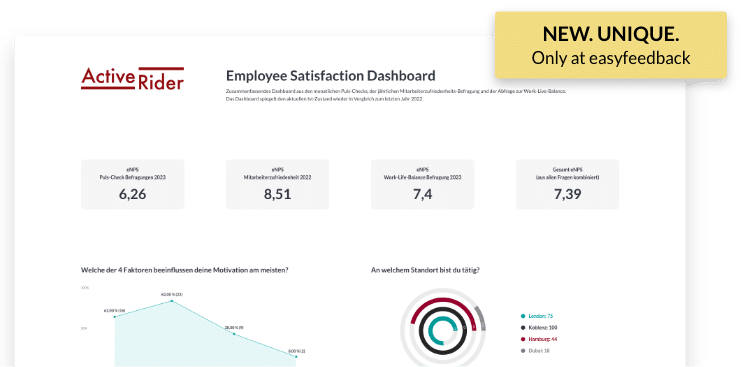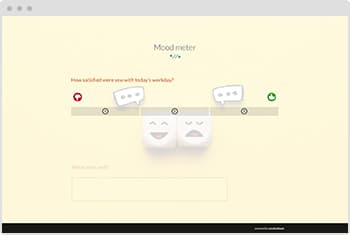Check the work-life balance of your employees with a survey

Ask if your employees' work-life balance is in balance with a simple survey.

“Identifying customer needs is an essential part of our business. easyfeedback accompanies us for many years as a loyal partner in this task. We particularly appreciate the intuitive usability of the survey tool as well as the professional support.“
Guild Lead User Experience Research

“We use easyfeedback for internal and external surveys – fast, comfortable and really easy! Straightforward and cordial support can always create a smile. We really appreciate the permanent development of the platform.“
Guest & Competitor Insights Analyst
Content and targets of this work-life balance survey template
Work, family, boyfriend, hobbies and more, many employees today struggle to balance the different areas of their lives. After all, if one area of life comes up short, it can have repercussions.
Especially if the professional everyday life merges into the private life, thus creating an imbalance between these areas of life. It can lead to employees having an increased stress level, being overworked, feeling increased pressure to perform or suffering from health consequences.
What can employers do to improve the work-life balance of their employees?
As an employer, you have a great influence on the separation between work and private life. With continuous employee surveys as well as measures to promote work-life balance through training offers or flexible working time models, you can help ensure that employees have a healthy work-life balance.
This promotes performance, strengthens well-being and increases the satisfaction of your employees.
Content:
• Questions about work-life balance
• Questions about the work situation
• Questions about leisure time
• Questions about the family situation
• Questions about company support measures
• Anonymous questions about demographics
Goals:
• Measure actual state
• Determine the physical strain
• Determine mental workload
• Promote a balance between private and work life
• Strengthen employee loyalty
• Strengthen employer brand

Data privacy protection „made in Germany“ (GDPR)

Anonymity functions for open feedback
Almost everything you need to know about work-life balance
1. What is work-life balance?
Work-life balance is the harmonious interaction between a person’s professional and private life. Through good self-organization on the one hand and the alignment of interests between employee and employer on the other, a healthy and balanced relationship between both areas of life should be achieved.
How exactly this relationship between the two spheres of life is to be achieved depends, on the one hand, on the personal ideas of the employees and, on the other hand, on the measures that a company offers for realization.
2. Which factors influence the work-life balance?
There are basically 4 factors that can influence people’s work-life balance both positively and negatively. These factors are called: body, performance and work, contacts and meaning.
The “body” factor is about issues such as health, relaxation, sports as well as nutrition. The “performance and work” factor is aimed at the professional path, personal prosperity as well as career. Private relationships as well as family play a role in the aspect “Contact” and in the factor “Meaning” points such as values, religion, love and more.
Now, how strongly each individual point affects a person’s work-life balance always depends on how important the respective factor is for a person.
There are people who attach more importance to the work area than to their private life. Accordingly, aspects such as body and contacts do not have as strong an impact on work-life balance as when private life is prioritized more.
3. What are signs of work-life balance imbalance?
Possible signs of an imbalance in a person’s work-life balance are many. Below we have listed 10 signs for you:
1. Permanent high stress
2. Feeling of increased pressure to perform
3. Feeling of being overwhelmed
4. Change in personal behavior
5. Psychosomatic complaints
6. No mental separation between private and working life
7. Problems with sleeping
8. Lack of interest in social contacts
9. Productivity decreases
10. Exhaustion
4. How important is work-life balance for employees?
Particularly in times of increasing pressure to perform due to the steady rise in the shortage of skilled workers and increased digital networking among each other, the separation between the working world and private life has become increasingly difficult.
It often happens that employees think about work even after work or on vacation, are called or feel they have to be available at all times. Something like this can have a long-term impact on health.
That’s why it’s important for employers to offer their employees a healthy work-life balance and encourage it through appropriate measures.
5. What are the benefits of a good work-life balance for companies?
Companies that offer their employees a healthy and supportive work-life balance benefit from several advantages at once.
A positive work-life balance not only increases employee satisfaction but also long-term commitment to the company, thus reducing employee turnover.
In addition, satisfied employees are more motivated and productive. They enjoy coming to work and are more productive, which also has an impact on the success of a company.
Last but not least: a healthy work-life balance also gets around on the job market. As a result, you enhance your image as an employer and benefit from an increased number of applications from new talent.
6. Are there measures to improve the work-life balance in the company?
Yes, there are. We have listed a few possible measures to promote it and explained them in more detail:
1. Offer employee benefits
Provide your employees with special offers that promote work-life balance, such as recreational opportunities during breaks, snacks and drinks, or in-house childcare.
2. Company health management
You can maintain and promote employee health with targeted measures such as ergonomic workstations, regular sports offerings or reintegration programs.
3. Flexible and location-independent working time models
Home office, flexitime, sabbaticals, job rotations and much more can promote the work-life balance of employees and increase satisfaction.
4. Offer training
Train employees on various health-related topics such as nutrition, time and stress management, or how to deal with conflicts, and promote events that strengthen team building.
You are in professional company







easyfeedback welcomes more than 740.000 participants per month







